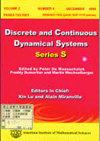拓扑优化的二尺度相场模型
IF 1
4区 数学
Q2 MATHEMATICS, APPLIED
引用次数: 0
摘要
在这篇文章中,我们考虑一个梯度流源于一个问题的两尺度拓扑优化。我们使用相场方法,在代价函数中加入一个具有障碍势的金兹堡-朗道项,它包含了通常的顺应性,但也包含了额外的贡献,包括惩罚项中的局部体积约束。本文分析了利用梯度流使这种能量最小化的问题。我们使用相关状态变量的正则化和离散化来证明所考虑系统的弱解的存在性。本文章由计算机程序翻译,如有差异,请以英文原文为准。
On a two-scale phasefield model for topology optimization
In this article, we consider a gradient flow stemming from a problem in two-scale topology optimization. We use the phase-field method, where a Ginzburg–Landau term with obstacle potential is added to the cost functional, which contains the usual compliance but also an additional contribution including a local volume constraint in a penalty term. The minimization of such an energy by its gradient-flow is analyzed in this paper. We use an regularization and discretization of the associated state-variable to show the existence of weak solutions to the considered system.
求助全文
通过发布文献求助,成功后即可免费获取论文全文。
去求助
来源期刊

Discrete and Continuous Dynamical Systems-Series S
MATHEMATICS, APPLIED-
CiteScore
3.70
自引率
5.60%
发文量
177
期刊介绍:
Series S of Discrete and Continuous Dynamical Systems only publishes theme issues. Each issue is devoted to a specific area of the mathematical, physical and engineering sciences. This area will define a research frontier that is advancing rapidly, often bridging mathematics and sciences. DCDS-S is essential reading for mathematicians, physicists, engineers and other physical scientists. The journal is published bimonthly.
 求助内容:
求助内容: 应助结果提醒方式:
应助结果提醒方式:


